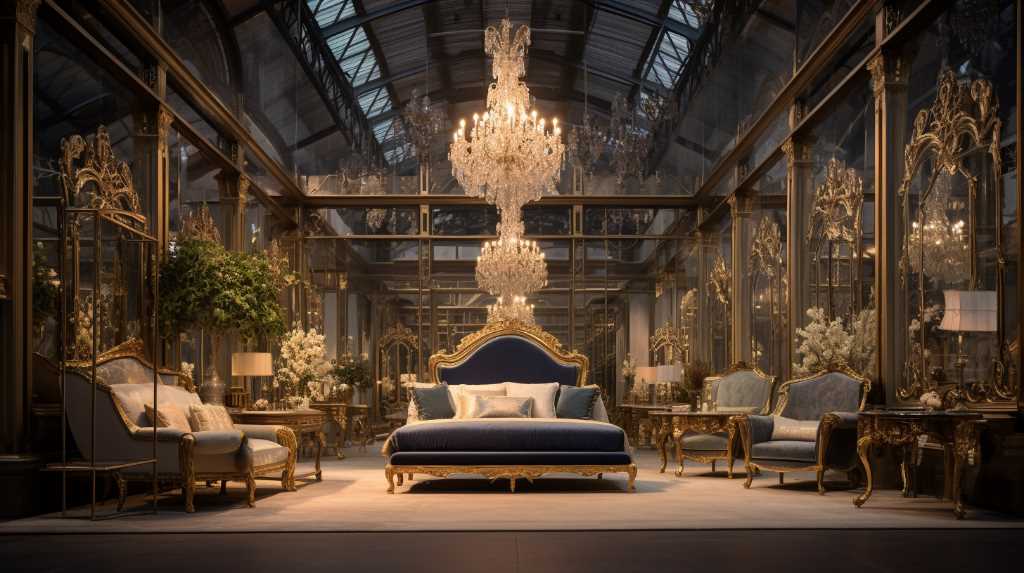
Wholesale Luxury Furniture
The UK’s luxury wholesale furniture sector is a pivotal force within the European furniture scene, with projections indicating growth from approximately USD 18.20 billion in 2023 to an estimated USD 21.30 billion by 2028. This market is recognized for its vitality, adjusting to shifting consumer tastes and an increased emphasis on both sustainable practices and the convenience of online shopping. These elements are driving the market forward, cementing the UK’s status as a prominent figure in Europe’s furniture industry.
A thorough analysis of past trends and the current state of affairs is essential for grasping the UK luxury wholesale furniture market’s enduring prosperity and impact. Internationally, the high-end furniture market has been valued at USD 21.67 billion as of 2022, with forecasts suggesting a climb to USD 33.31 billion by 2030. This global growth reflects a broader trend in luxury goods, of which the UK is a significant contributor. The rise in the market is not just about aesthetic appeal but also about functionality and the growing awareness of environmental impacts. The shift towards online retail has opened new avenues for consumers, who now seek quality and exclusivity alongside convenience.
In-depth research into consumer behavior shows that UK shoppers are increasingly drawn to unique designs and eco-friendly materials. This is not just a superficial preference but a deep-seated desire to invest in high-quality pieces that stand the test of time and align with personal values regarding the environment.
The luxury furniture market in the UK doesn’t operate in isolation; it is interconnected with global economic factors and design trends. For instance, the influence of international trade agreements, currency fluctuations, and even events like the Milan Furniture Fair can have ripple effects on what UK wholesalers stock and sell.
For retailers and interior designers looking to source luxury furniture, the UK market offers a diverse array of options. Brands that have built reputations on craftsmanship and sustainability are often sought after. These trends suggest a promising future for the UK luxury furniture market, provided it continues to adapt to the evolving landscape of consumer demands and global economic conditions.
In summary, the UK’s luxury wholesale furniture market is not just growing financially; it’s evolving culturally, reflecting a society that values quality, sustainability, and online accessibility. Understanding these dynamics is key to any business looking to thrive in this affluent sector.
Historical Overview of the UK Furniture Market
The UK furniture market has undergone notable change over the last sixty years, influenced by evolving tastes among buyers and the prevailing design movements. The journey of furniture styles in the UK mirrors a complex mix of societal shifts, economic pressures, and changes in population makeup.
The 1960s saw the introduction of factory-produced, Scandinavian-style furnishings, while the 1990s were characterized by a preference for streamlined modern designs. Signature pieces like the Eames chair and the Chesterfield sofa have come to represent the pinnacle of British design. Cultural shifts towards minimalism and a focus on eco-friendly materials have steered the direction of furniture aesthetics. Additionally, the economy, including periods of recession and property market fluctuations, has shaped buying habits and the demand for home furnishings. A thorough look at the UK furniture market’s past sheds light on what might shape this sector in the times ahead.
Economic downturns and property market upswings, for instance, have directly influenced how much consumers are willing to spend on furnishing their homes. During prosperous times, there tends to be an uptick in more luxurious, statement pieces that signify wealth and comfort. Conversely, during leaner economic periods, there’s a noticeable shift towards functional, cost-effective solutions.
Moreover, as the population’s age demographic has changed, so too have the types of furniture that are in demand. The rise in single-person households and smaller living spaces in urban areas, for example, has led to an increased need for space-saving and multi-functional furniture designs.
Today, the UK furniture market is marked by an appreciation for both the craftsmanship of traditional pieces and the innovation of modern designs. Consumers are looking for items that not only look good but also have a reduced environmental impact, aligning with a broader societal push towards sustainability.
To understand where the industry might be headed, it’s vital to consider current trends such as the growing influence of technology in our homes, which is leading to the emergence of ‘smart’ furniture, and the continued popularity of bespoke, artisanal pieces that offer a personal touch in an otherwise mass-produced market.
Current Trends in the UK Luxury Furniture Market
In an examination of the UK’s high-end furniture market, it’s evident that consumer tastes are ever-changing, with a growing focus on eco-friendly practices and the convenience of online shopping. The following table provides a detailed look at the significant trends influencing this sector:
| Trend | Description |
|---|---|
| Innovative Materials | High-end furniture companies are experimenting with new materials to craft distinctive and stylish items, like reclaimed wood and recycled metals, to cater to environmentally mindful shoppers. |
| Designer Collaborations | Increasingly, partnerships between high-end furniture brands and esteemed designers are giving rise to exclusive, limited-run furniture lines that satisfy the sophisticated preferences of well-to-do buyers. |
| Technology-Infused Pieces | Furniture that incorporates technology, such as pieces with integrated speakers, wireless charging stations, and customizable settings, is becoming more popular for its added convenience and improved living experiences. |
| Eco-Conscious Sourcing | There is a heightened focus among luxury furniture companies on sourcing materials responsibly, which includes the use of ethically obtained materials, adoption of green production techniques, and support for fair trade. |
| Personalized Options | The ability to tailor furniture to one’s personal taste is a significant movement in the UK’s luxury furniture scene. Consumers can select from various materials, finishes, and sizes to commission one-of-a-kind pieces that echo their personal aesthetic. |
These trends are indicative of a shift in consumer behavior and an increased demand for furniture that is both environmentally friendly, technologically integrated, and customizable. UK luxury furniture brands that successfully respond to these preferences with innovative offerings are poised to succeed in a highly dynamic market.
Major Wholesale Hubs and Their Unique Styles
Major wholesale centers across the UK are well-known for their distinct furniture styles. These centers have become fertile grounds for new designers who introduce fresh ideas and original concepts to the field.
A standout aspect of these wholesale centers is the extensive range of bespoke options they offer. Customers can select from various materials and finishes and tailor designs to suit their exact needs, allowing them to craft furniture that is as individual as they are.
Cross-border partnerships also play a pivotal role in these hubs. Designers and producers often collaborate with artists and craftspeople globally, resulting in furniture that reflects a blend of cultural inspirations.
Additionally, alliances with retailers are prevalent, enabling wholesalers to access a broader customer base and strengthen their position in the market.
These factors all contribute to the vibrant and ever-changing nature of the UK’s high-end wholesale furniture sector.
Sustainability in Luxury Furniture
How are makers and sellers of high-end furniture responding to the increased customer interest in eco-friendly products?
With a growing number of consumers looking for greener options, those in the luxury furniture market are taking steps to satisfy this preference. A significant move in this direction is the choice to use materials that are kinder to the environment when crafting luxury furnishings. Leading brands in this sector are now prioritizing the procurement of low-impact resources, such as wood that has been repurposed, metals that have been recycled, and textiles made from organic sources.
In their manufacturing processes, these companies are also striving to cut down on waste and the use of energy, as well as turning to sources of energy that can be regenerated. Sellers play a pivotal role too, by highlighting eco-friendly luxury furniture, informing customers about the advantages of these products, and maintaining transparency regarding the ecological footprint of their offerings.
Through these efforts, those who produce and sell luxury furniture are demonstrating their commitment to sustainable practices and contributing to an industry that is more mindful of its environmental responsibilities.
E-Commerce and Technological Integration
The fusion of e-commerce with cutting-edge technology has significantly altered how buyers in the UK shop for high-end furniture. Shoppers now have the convenience of browsing extensive furniture collections from where they’re most comfortable. Virtual showrooms are becoming a go-to for many, offering the ability to tour furniture offerings and see how they would fit in a personalized space. The use of augmented reality apps takes this a step further by letting customers see a virtual rendition of how different furniture pieces would look in their actual living spaces, aiding in making more informed decisions.
These tech-driven tools make the shopping process not just simpler, but also more informed, as customers gain a better perspective on what works for their homes. As technological progress marches on, its synergy with e-commerce is expected to keep transforming the luxury furniture landscape in the UK.
Why is this shift significant? The move to digital platforms addresses the growing demand for convenience and personalized shopping experiences. Customers no longer have to guess how a piece of furniture might look in their home; they can see it for themselves before making a purchase. This could lead to higher satisfaction rates and potentially fewer returns, benefiting both consumers and retailers.
In the field of high-end furniture sales, these tech integrations could become a deciding factor for companies aiming to stay ahead in a market where customer experience is king. Retailers that can offer immersive, interactive online shopping experiences may find themselves with an edge in attracting and retaining discerning customers.
Luxury Segment Growth and Consumer Trends
The UK’s high-end furniture market is experiencing significant expansion, with consumer behavior influencing its direction. Notably, influencers are shaping buying habits by featuring elegant furniture, thereby motivating their followers to seek out similar luxury items. Personalization is becoming more prominent, with shoppers looking for distinctive furnishings that mirror their personal style and taste.
As city living becomes more common and residential spaces shrink, there’s a rising demand for luxury furniture designed to fit these compact environments. Eco-consciousness is also on the rise, with a shift towards materials like repurposed wood and recycled metals, as buyers are placing more importance on environmentally friendly choices.
Social media’s influence is undeniable in the luxury furniture sector, broadening consumer exposure to various designs and creative ideas. The UK’s luxury furniture market is propelled by a desire for exclusive, customized, and eco-responsible items that resonate with personal values and lifestyle choices.
| Luxury Segment Growth and Consumer Trends | |
|---|---|
| 1. Influencers | Influential in directing buying habits by presenting elegant furniture and driving their audience towards similar luxury items. |
| 2. Customization | On the rise as shoppers look for unique furnishings that echo their personal style and taste. |
| 3. Small Spaces | The trend towards urban living and constrained living areas has increased the need for luxury furniture that fits these spaces. |
| 4. Sustainable Materials | A shift towards eco-friendly choices with a focus on materials like repurposed wood and recycled metals. |
| 5. Impact of Social Media | A powerful force in the luxury furniture sector, widening consumer access to a variety of styles and creative concepts. |
Challenges in the Furniture Market
The UK luxury wholesale furniture market is experiencing growth, but it’s also grappling with significant hurdles. Rising inflation rates are a key concern, leading to costlier production processes and a decrease in how much consumers are willing to spend. The market is also dealing with supply chain issues that have emerged from global events, such as the pandemic and trade disputes. These problems have caused a scarcity of raw materials and a spike in transportation expenses, which can hinder production schedules and the availability of furniture.
Additionally, economic instability affects how confident consumers feel about investing in big-ticket items like furniture. To remain competitive, furniture manufacturers and retailers in the luxury segment must be inventive and flexible, seeking fresh approaches to satisfy customer needs and streamline their supply chains.
Role of Local Artisans and Craftsmanship
The UK luxury wholesale furniture market owes a significant portion of its success to the skilled local artisans and their dedication to craftsmanship. These artisans apply time-honored methods and a deep commitment to environmentally responsible practices, creating distinctive and eco-friendly furniture. When designers and local craftsmen come together, the result is custom, superior quality furniture that distinguishes itself from the mass-produced varieties. Artisans often opt for sustainable materials like reclaimed timber or repurposed metal, thus reducing the ecological footprint of their products. Supporting these local talents not only helps in preserving age-old craft traditions but also stimulates economic development and yields environmental dividends. A focus on green practices and adherence to classic crafting techniques bolsters the market’s distinctiveness and gives it an edge over others.
Craftsmanship’s Impact on the Environment and Economy
The connection between skilled local craftsmen and environmental and economic advancement is clear. For instance, using reclaimed wood prevents the unnecessary felling of trees, while repurposing metals reduces the demand for new mining operations, curtailing pollution and habitat disruption. Moreover, when consumers choose furniture made by these artisans, they are investing in the local economy. This not only provides a livelihood for the craftsmen but also circulates money within the community, strengthening local businesses.
Sustaining Tradition and Quality
The collaboration between innovative designers and seasoned artisans yields pieces that reflect a blend of creativity and tradition. Such partnerships often lead to original designs tailored to the specific preferences of customers, thereby offering a personalized touch that factory-made furniture simply cannot match. The attention to detail and quality control possible in smaller, artisan-led production settings ensures that each piece of furniture is not just a product but a testament to the craft.
Why Choose Artisan-Made Furniture?
Choosing furniture crafted by local artisans means investing in items that tell a story. Each piece bears the marks of human hands and individual artistry, offering a connection to the maker and the crafting process that is absent in industrial manufacturing. Moreover, artisan-made furniture can often be customized to fit particular spaces or styles, providing a level of personalization and customer service that larger manufacturers may not be able to offer.

